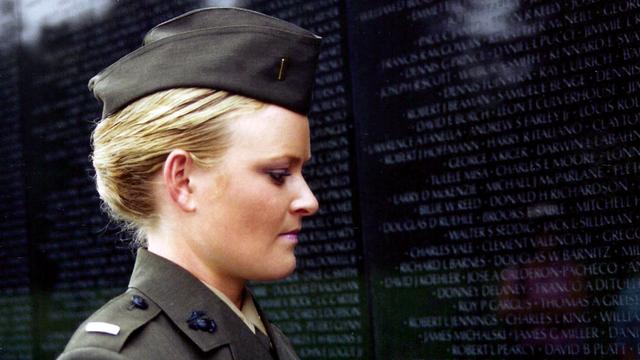Let's choose Military Sexual Trauma metrics with care:
Words matter, and numbers are the language of logic.
Words matter, and numbers are the language of logic.
 |
| Image attribution: CloudFront.net, promotional photo for Invisible War |
"Military sexual trauma [MST], which encompasses everything from sexual harassment to rape, is now the leading cause of post-traumatic stress disorder among women in the U.S. Military. Female Soldiers today are 180 times more likely to be sexually assaulted by a fellow Soldier than killed by an enemy."
The Military’s Sexual Assault Epidemic, 30 March 2013, The Week, emphasis added.
I want to help solve the military's sexual assault epidemic. The first half of the epigraph above has captured my attention and harnessed my passion as a decision analyst serving the military community. That said, there is something deeply concerning to me about the metric cited in the second half of the quote above, namely, that a woman in uniform is 180 times more likely to suffer military sexual trauma (MST) than to be killed by the enemy.
But the metric is concerning for an unexpected reason: it's harmful to the cause! To say that a woman in uniform is 180 times more likely to be sexually assaulted by a fellow Soldier than killed by an enemy certainly catches one's attention in dramatic fashion. I'll grant that. Contrasting MST to combat death may be intended to communicate the severity of the MST epidemic, but it is a flawed comparison which sets wrong expectations, uses wrong standards, and addresses the wrong population. The ratio is seriously harmful to the victims of MST and the military's efforts to deal with the problem of MST.
Bad metrics backfire. Let me first explain what is wrong with this metric, and then propose an alternative.
First of all, we have a problem with expectations. The bar has been set at 180, and we expect the ratio to get smaller as the situation improves. However, the ratio of MST to combat deaths is only going to get higher. We have not seen the end of trauma-induced rage, abuse of power, and other combat-related issues contributing to the rise in sexual violence within the military. The causes of the spike in sexual violence will not stop producing their ill-effects overnight. As the wars draw down, combat deaths will decrease, which alone will cause the ratio to climb. Yet over the same time, the numbers of people acting out in sexually violent ways will likely increase. And hopefully, the reporting of these incidents will increase as well. So the denominator will drop off to zero while the numerator may well spike.
What will media sources such as The Week have to say when the ratio goes from 180 to 200? 300?
- Will they condemn the Army's SHARP program?
- Will they pillory the DoD's SAPRO again, as they rightfully did in the movie, the Invisible War?
- Will they declare leaders from the SecDef on down inept or morally corrupt?
- Will concerned citizens press their lawmakers to rewrite the UCMJ to remove certain authorities from all Commanders, instead of prosecuting any Commander who abuses his authority?
All of these reactions would be horrible outcomes for victims, undermining solid efforts to address the MST problem, and leading to further erosion of order and discipline in the ranks. We must replace this 180 metric with one which sets proper expectations.
- We want combat deaths to decline.
- We want 100% of MST incidents to be reported. We have reason to believe the majority of incidents are not reported, so even if the actual incident rate is unchanged, we actually want the numbers of reported cases to increase.
- And as soon as possible, we want the rate of incidents to drop off dramatically.
The proper expectation we should set and focus on is that the ratio of reported incidents to actual incidents will climb to 100% from approximately 30% now, regardless of combat casualties.
Secondly, we have the issue of standards. Problems like bullying, suicide, drug abuse, armed robbery, and sexual violence are vexing, of course. However, given that the military is but a subset of the society it serves, it's irrational to expect perfect behavior from the military. People are people, and there will be some level of noisy behavior in any population. That's why we invest in our leaders to set positive examples, and to counsel and correct behavior that detracts from good order and discipline. But, leaders are people, too. I am not excusing crime by any means, just pointing out that "zero tolerance" means that crime will not be tolerated, not that it will not occur! Therefore, in order to maintain higher than "normal" standards of good order and discipline expected in a military unit, it's essential that commanders have authority to instill values, reform potential miscreants before they offend, and to prosecute them fully if they offend.
The phenomenon of sexual violence within the military is only a matter requiring Congressional oversight when such crimes occur disproportionately within the military. That appears to be the case right now. The task is to drive the rate of incidents to a rate below the civilian population. Any attempt to drive MST to zero is misguided because it is doomed to fail. We must get the standards right, and enforce them.
- This involves excoriating any leader who abuses his or her special position of trust and confidence.
- The reaction of contracting out Drill Sergeants because some Drill Sergeants abused recruits is insane. Prosecute the offending Drills to the max!
- The reaction of rewriting Section 60 of the UCMJ because one Convening Authority may have made a questionable call is ludicrous. Prosecute the allegation and punish the offender.
Thirdly, we must use terms that accurately describe the population under consideration.
- MST is not an Army problem, so let's not single out Soldiers. The term, "Servicemembers," includes Sailors, Airmen, Marines, Coasties, and Soldiers, and is therefore preferred.
- MST is not a female problem. Most cases involve male perpetrators and female victims, but there are plenty of male on male, female on male, and female on female cases. The MST issue is gender neutral.
- MST is not a sex problem. The perpetrators are not looking for sexual gratification. The perpetrators are looking for power, and sex is one weapon in the arsenal. The issue then is power dynamics, not sex or sexual tensions.
- MST is not a combat problem. The stress of combat, indeed the stress of repeated combat tours is likely a contributor to the military's failure to prevent MST. While combat may exacerbate MST, combat is not the root cause. Ending the wars will not solve the problem.
- MST is not a civilian problem. Until you have filled out your pre-deployment will and life insurance beneficiary forms, you have not begun to confront the prospect of laying down your life in combat. Military Sexual Trauma is a particular subset of sexual violence.
There are sociopaths in the world, and unfortunately, some make it into the military. It's unrealistic to put a group of mostly young people (including a percentage of society's emotionally challenged) through the gauntlet of a decade of war and expect them to behave collectively just as do their civilian counterparts. To solve the MST problem, we must focus our efforts on the target population: Servicemembers.
- male and female,
- all ranks,
- and all branches of service.
Female Soldiers today are 180 times more likely to be sexually assaulted by a fellow Soldier than killed by an enemy. That sounds horrible until one realizes that there are an estimated 19,000 sexual assaults per year in the military. These assaults take place among a million uniformed servicemembers. Servicemembers are exposed to the risk of blue-on-blue sexual assault 24 x 7, while they are only exposed to the risk of combat death when they are deployed to combat.
A Better Metric
So far we have agreed that yes, there is a problem in the military and sexual violence is occurring at a rate higher than in society at large. And yes, sexual violence tears a team apart. It violates not only the victim but the values of the unit and the special trust citizens have in their military leaders to maintain good order and discipline while fighting and winning the Nation's wars. But the bottom line is that the metric used to describe the magnitude of the MST issue must be a comparison between military and civilian sexual violence.
The only real question is, at what point does a young person's risk of sexual violence have no bearing on his or her choices between military service, attending college, or getting a civilian job?
We send our sons and daughters into harm's way for reasons which reflect our National values and our vital National interests. That decision should be neutral on the question of blue-on-blue violence. We have a situation requiring Congressional oversight only when the decision is not neutral. If it's neutral or in favor of the military and the rate of incidents is greater than zero, there is still an MST problem but Congress can leave it to the military to address.
It will be a long time before the efforts of SAPRO and SHARP achieve end-state goals
- completely empower victims and potential victims,
- engage bystanders and colleagues to prevent and intervene, and
- control or eliminate the perpetrators and potential perpetrators.
It could be years of sustained effort before DoD again looks like society at large in the area of sexual violence. During that same multi-year period of what we can only hope will be sustained effort, the bogus 180 metric can only go up, falsely implying that the situation is getting worse! We WANT reports of incidents to go UP. We WANT combat casualties to go DOWN. What is 180 now will double if we get what we WANT! And if we do nothing to counter the misinformation wrapped up in the 180 metric, pressure from society will undermine the military's best efforts.
Rape is always wrong and always an issue of utmost importance, perhaps particularly in high-performing teams such as our military formations. Given that some people do go to combat, the only time that MST is an issue for Congress, parents, or enlistees is when a person going to combat has a higher chance of being raped than his or her civilian counterpart.
When we as a Nation send our sons and daughters into harm's way, we have a right to insist that their leaders keep the risks under control. We must also invest in those leaders and give them the tools they need to perform that role. And yes, the flip side is also true: bad leaders must be held accountable.
- the correct expectations,
- the proper standards, and
- the actual people under consideration.
Thank you for your time in reading this message. Feel free to circulate it. Comments are welcome.
Questions for interaction:
- Have you seen The Invisible War? What did you think of it? If not, will you?
- Have you or someone you know been affected by MST? Do you know where to get help?
- Have you come across any other metrics that seem to undermine the cause they supposedly support?









